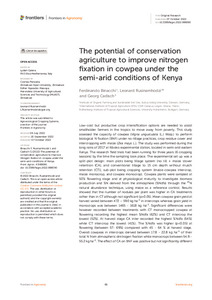| dc.contributor.author | Binacchi, F. |
| dc.contributor.author | Rusinamhodzi, L. |
| dc.contributor.author | Cadisch, G. |
| dc.date.accessioned | 2022-10-18T09:42:18Z |
| dc.date.available | 2022-10-18T09:42:18Z |
| dc.date.issued | 2022-10-07 |
| dc.identifier.citation | Binacchi, F., Rusinamhodzi, L. & Cadisch, G. (2022). The potential of conservation agriculture to improve nitrogen fixation in cowpea under the semi-arid conditions of Kenya. Frontiers in Agronomy, 4: 988090, 1-12. |
| dc.identifier.issn | 2673-3218 |
| dc.identifier.uri | https://hdl.handle.net/20.500.12478/7879 |
| dc.description.abstract | Low-cost but productive crop intensification options are needed to assist smallholder farmers in the tropics to move away from poverty. This study assessed the capacity of cowpea (Vigna unguiculata (L.) Walp.) to perform biological N fixation (BNF) under no-tillage practices, crop residue cover and intercropping with maize (Zea mays L.). The study was performed during the long rains of 2017 at Kiboko experimental station, located in semi-arid eastern Kenya. The research field trials had been running for three years (6 cropping seasons) by the time the sampling took place. The experimental set up was a split-plot design: main plots being tillage system (no till + maize stover retention (CA), and conventional tillage to 15 cm depth without mulch retention (CT)), sub-plot being cropping system (maize-cowpea intercrop, maize monocrop, and cowpea monocrop). Cowpea plants were sampled at 50% flowering stage and at physiological maturity to investigate biomass production and %N derived from the atmosphere (%Ndfa) through the 15N natural abundance technique, using maize as a reference control. Results showed that the number of nodules per plant was higher in CA treatments rather than in CT although not significant (p>0.05). Mean cowpea grain yield at harvest varied between 472 – 590 kg ha‐1 in intercrops whereas grain yield in monocrops was between 1465 - 1618 kg ha-1. Significant differences were however recorded between treatments with CT monocropped cowpea at flowering recording the highest mean %Ndfa (62%) and CT intercrop the lowest (52%). At harvest stage CA inter recorded the highest %Ndfa (54%) while CT intercrop the lowest (41%). The %Ndfa was higher (p<0.05) at flowering (between 57- 69%) compared with 45 - 64 % at harvest stage. Overall cowpeas in intercrops derived between 17.8 - 22.8 kg ha-1 of their total N from atmospheric dinitrogen fixation while monocrops between 54.9 - 55.2 kg ha-1. The effect of CA on BNF was positive but not significantly different from CT. These results suggest that CA has the potential to enhance the BNF process but there is a need to explore in future alternative spatial arrangement and variety choice in intercropping of cowpea and maize to optimize the BNF process. |
| dc.description.sponsorship | Australian Centre for International Agricultural Research |
| dc.description.sponsorship | Bill & Melinda Gates Foundation |
| dc.format.extent | 1-12 |
| dc.language.iso | en |
| dc.subject | Sustainable Intensification |
| dc.subject | Smallholders |
| dc.subject | Farmers |
| dc.subject | Cowpeas |
| dc.subject | Conservation Agriculture |
| dc.subject | Biological Nitrogen Fixation |
| dc.subject | Cropping Systems |
| dc.subject | Kenya |
| dc.title | The potential of conservation agriculture to improve nitrogen fixation in cowpea under the semi-arid conditions of Kenya |
| dc.type | Journal Article |
| cg.contributor.crp | Grain Legumes |
| cg.contributor.affiliation | Justus Liebig University |
| cg.contributor.affiliation | International Institute of Tropical Agriculture |
| cg.contributor.affiliation | University Hohenheim |
| cg.coverage.region | Africa |
| cg.coverage.region | East Africa |
| cg.coverage.country | Kenya |
| cg.coverage.hub | Headquarters and Western Africa Hub |
| cg.identifier.bibtexciteid | BINACCHI:2022 |
| cg.authorship.types | CGIAR and advanced research institute |
| cg.iitasubject | Agronomy |
| cg.iitasubject | Cowpea |
| cg.iitasubject | Crop Systems |
| cg.iitasubject | Food Security |
| cg.iitasubject | Grain Legumes |
| cg.iitasubject | Plant Breeding |
| cg.iitasubject | Plant Production |
| cg.iitasubject | Smallholder Farmers |
| cg.journal | Frontiers in Agronomy |
| cg.notes | Open Access Article; Published online: 07 Oct 2022 |
| cg.accessibilitystatus | Open Access |
| cg.reviewstatus | Peer Review |
| cg.usagerightslicense | Creative Commons Attribution 4.0 (CC BY 0.0) |
| cg.targetaudience | Scientists |
| cg.identifier.doi | https://dx.doi.org/10.3389/fagro.2022.988090 |
| cg.futureupdate.required | No |
| cg.identifier.issue | 988090 |
| cg.identifier.volume | 4 |
| cg.contributor.acknowledgements | This study was made possible through the project on Sustainable Intensification of Maize-Legume Systems for Food Security in Eastern and Southern Africa - SIMLESA funded by Australian Centre for International Agricultural Research (ACIAR) through a grant to CIMMYT (CSE/2009/ 024 variation 3), and also by the Drought Tolerant Maize for Africa (DTMA) supported by the Bill and Melinda Gates Foundation (BMGF, grant OPPGD1390) and CGIAR Research Program on Maize (CRP MAIZE). We are grateful to George Oriyo for managing the long-term trial as well as data collection. |

